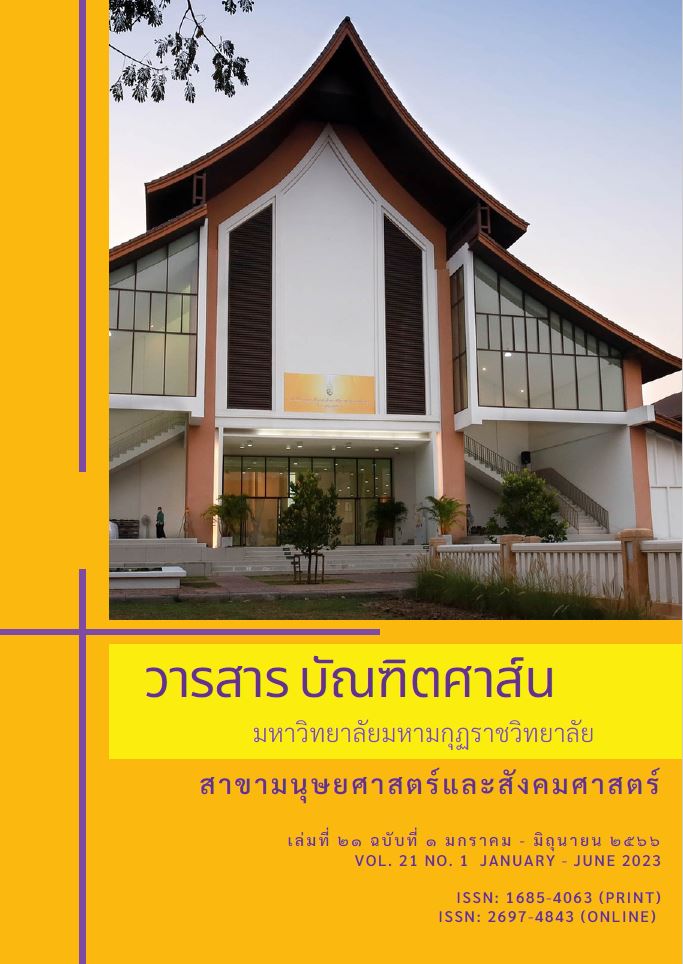การเสริมสร้างสมรรถนะทรัพยากรมนุษย์เชิงพุทธกลุ่มบุคคล 3 วัย บนฐานพุทธธรรม
คำสำคัญ:
การเสริมสร้างสมรรถนะ, ทรัพยากรมนุษย์เชิงพุทธ, กลุ่มบุคคล 3 วัย, ฐานพุทธธรรมบทคัดย่อ
หลักกัลยาณมิตรธรรม ประกอบด้วย 1) ปิโย ต้องมีมนุษย์สัมพันธ์เป็นต้นแบบแก่สังคม 2) ครุ คือ ความน่าเคารพ มีความประพฤติสมควรแก่ฐานะ มีหลักการดาเนินชีวิตในทางที่ถูกต้องชอบธรรม 3) ภาวนีโย มีความเป็นบัณฑิตเป็นที่ยกย่อง มีองค์ความรู้และภูมิปัญญา 4) วตฺตา จ การรู้จักชี้แจงให้เข้าใจ รู้ว่าเมื่อไรควรพูดอะไรอย่างไร 5) วจนกฺขโม มีความอดทนต่ออุปสรรคในทุกด้าน 6) คมฺภีรญฺจ กถ กตฺตา สามารถอธิบายเรื่องยุ่งยากซับซ้อน ให้เข้าใจ และให้เรียนรู้ เรื่องราวที่ลึกซึ้งยิ่งขึ้นไป และ 7) โน จฏฺฐาเน นิโยชเย คือ ไม่แนะนาหรือชักจูงไปในทางเสื่อมเสีย รูปแบบการเสริมสร้างสมรรถนะทรัพยากรมนุษย์กลุ่มบุคคล 3 วัย บนฐานพุทธธรรม ประกอบด้วย 5 รูปแบบ ดังนี้ รูปแบบที่ 1 การสร้างสภาพแวดล้อมที่เอื้อต่อการพัฒนาและเสริมสร้างศักยภาพมนุษย์ รูปแบบที่ 2 การพัฒนาเด็กตั้งแต่ช่วงการตั้งครรภ์จนถึงปฐมวัย โดยจัดให้มีการเตรียมความพร้อมให้แก่พ่อแม่ก่อนการตั้งครรภ์ รูปแบบที่ 3 การพัฒนาช่วงวัยเรียน/วัยรุ่น จัดให้มีการพัฒนาทักษะความสามารถที่สอดรับกับทักษะในศตวรรษที่ 21 โดยเฉพาะทักษะด้านการคิดวิเคราะห์สังเคราะห์ สามารถแก้ปัญหาที่ซับซ้อน มีความคิดสร้างสรรค์ การทางานร่วมกับผู้อื่น รูปแบบที่ 4 การพัฒนาและยกระดับศักยภาพวัยแรงงาน ด้วยการยกระดับศักยภาพทักษะและสมรรถนะของคนในช่วงวัยทางานให้สอดคล้องกับความสามารถเฉพาะบุคคลและความต้องการของตลาดแรงงาน รูปแบบที่ 5 การส่งเสริมศักยภาพวัยผู้สูงอายุ โดยส่งเสริมการมีงานทาของผู้สูงอายุให้พึ่งพาตนเองได้ทางเศรษฐกิจ และร่วมเป็นพลังสาคัญต่อการพัฒนาเศรษฐกิจ ชุมชนและประเทศ
เอกสารอ้างอิง
Chuanpis SitThiThada. (2009). Performance Model of Effective Basic School Administrators. Doctor of Philosophy Thesis. Graduate school: Silpakorn University.
Danai Thianphut. (2007). Ability in viewpoint. Bangkok: AR Information and Public Relations.
David McClell. (2004). A guide to job competency assessment. The United State of America: Davies-Black Publishing. a division of CPP. Inc.
Hessong & Thomas. (1987). Introduction to education. New York: McMillan.
Kunlawee Wutikorn. (2016). Competency Development Pattern for Elderly Caregivers. A Dissertation Degree of Doctor of Philosophy (Organization Development and Human Capability Management). Graduate School: College of Commerce Burapha University.
Macquarie, Thesaurus. (1992). Collins co build dictionary English Languae. Sydney: The Macquarie Library Pty.
McClelland D.C. (1973). Test for Competence, rather than intelligence. American Psychologists, 17 (7).
Mahachulalongkornrajavidyalaya University. (1992). Thai Tripitaka. Bangkok:
Mahachulalongkornrajavidyalaya University.
Sucha Chanem. (1993). Child Psychology. Bangkok: Thaiwattanapanich.
Patchlada Suwannual, Phramahakrisada Kittisobhano (Saelee), Phrakhrusamuditthaphum Inthacha. (2021). “Buddhist Human Resource Development Management”. Journal of MCU Nakhondhat. ( Vol.8 No.4 April, 2021): 142-156.
Richard, Boyatzis. (1982). The Competency Manager: A Model for Effective Performance. New York: John Wiley & Son.
Robert S. Kaplan & David P. Norton. (2004). Strategy MAPD: converting intangible assets into tangible outcome. United States of America: Harvard Business School Publishing Corporation.
Spencer, L.M., & Spencer. (1993). S.M. Competence at work Model For superior
performance. New York: Wiley.
Teacher civil service and educational personnel, Office of the Commission. (2002). National Education Act 1999 Amendment (Version 2) 2002. Bangkok: The Office of the Commission Teacher civil service and educational personnel.
_______. (2002). Announcement of OTEPC regarding standards of teacher civil service and personnelEducation. Bangkok: Office of the Teacher Civil Service Commission and Educational Personnel.
Thamrongsak Kongkasawat. (2008). Practical Competency ... How did they do it? Bangkok: Promotion AssociationTechnology (Thai-Japanese).
Teacher civil service, Office of the Commission (2001). Towards the professional path. Bangkok: Thammasat University.
Tippa Chetchaowalit. (1998). Developmental Psychology for Nurses. Songkhla: Suburban Printing.
ดาวน์โหลด
เผยแพร่แล้ว
รูปแบบการอ้างอิง
ฉบับ
ประเภทบทความ
สัญญาอนุญาต
ลิขสิทธิ์ (c) 2023 มหาวิทยาลัยมหามกุฏราชวิทยาลัย

อนุญาตภายใต้เงื่อนไข Creative Commons Attribution-NonCommercial-NoDerivatives 4.0 International License.
บทความวิชาการและบทความวิจัยในวารสารฉบับนี้ถือเป็นความรับผิดชอบของผู้เขียนเท่านั้น บทความที่ได้รับการตีพิมพ์ในวารสารบัณฑิตศาส์น ถือเป็นลิขสิทธิ์ของมหาวิทยาลัยมหามกุฏราชวิทยาลัย ตามพระราชบัญญัติลิขสิทธิ์



